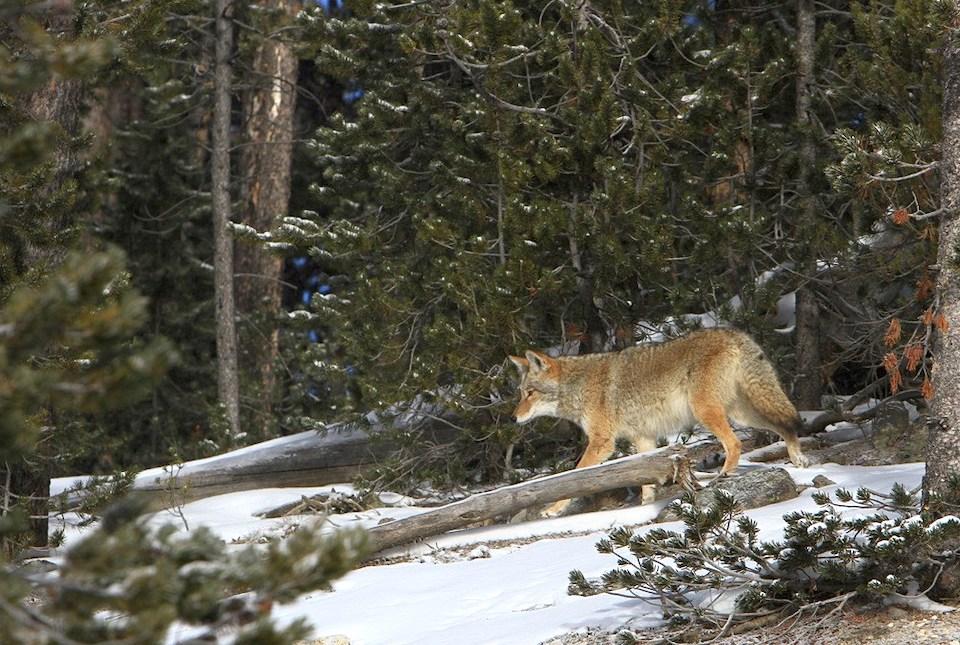
A coyote with a thick winter coat walks through snowy, dense forest in Yellowstone National Park/NPS
By Julie West, communications specialist, National Park Service Natural Sounds and Night Skies Division
Yellowstone National Park, January 2017: When the howling started in predawn darkness, natural sounds recordist Jacob Job signaled to his research assistant to stop. Wolves. Cold and crouched in snow in the remote backcountry of the park with microphones and recording gear to the ready, the Colorado State University scientists waited and listened. Silence. Then … the stealthy sound of crunching footsteps approaching.
“There were lots of animals, and they were getting closer. They were circling us. I was getting a little worried because it was dark and we could not see them. But I was also curious. All of a sudden I heard a ‘Yip” and knew we were safe.”
Coyotes. The pack was waking up. They had surrounded the scientists in every direction. Then they started howling. Job got it all “on tape.”
“It was the most incredible recording!” he exclaimed. “And at the end, the wolves started up again.”
Listen to the recording: https://soundcloud.com/gaviaimmer/coyotes-wake-up-in-yellowstone.
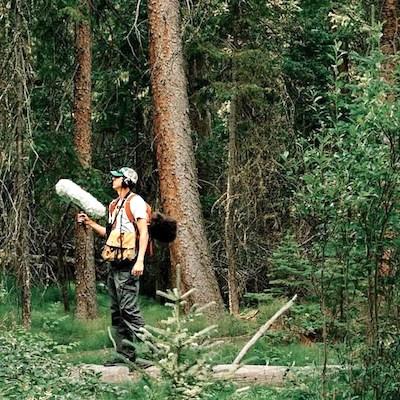
Summer scene of Jacob Job recording in a forest at Wild Basin, Rocky Mountain National Park, Colorado/Photo courtesy of Jacob Job
Exceptional Sounds
Job’s work introduces him to experiences not common to most park visitors. He manages the CSU Listening Lab through the Sound and Light Ecology Team in Fort Collins as part of a research associate partnership between the National Park Service Natural Sounds and Night Skies Division, and CSU Departments of Biology and Fish, Wildlife, and Conservation Biology. The Listening Lab is the hub where he and students analyze thousands of hours of audio recordings from national parks. He also records in the field, with a focus on wildlife. The NPS uses these recordings to advance understanding about the ecological and cultural soundscapes unique to each park, and to reduce noise so that visitors can enjoy the natural park setting. Equally important, reducing noise allows animals to hear sounds, which they depend on for survival. Doing so also increases opportunities for park visitors to see them.
Job said he wants people to be captivated by the sounds of nature by getting outdoors and having their own experiences. But you don’t have to venture where he goes in order to hear exceptional sounds in parks.
“People can hear a range of sounds while hiking on trails or in the backcountry simply by being quiet,” he said. “The more you listen, the more you’ll hear. If you’re patient and spend enough time out there, you’ll experience the coolest things in the world.”
In doing so, he hopes people will gain newfound appreciation for what the sounds reveal about animals and other natural sources, and the ecosystems in which they occur.
Whether people are active outdoors or not, Job’s recordings provide a great way to hear compelling park sounds they might not otherwise hear. Recordings of wolves and coyotes are the tip of the iceberg. Elk, frogs, loons, moose, owls, and songbirds are among the many animals he has documented.
Binaural Recording
In order to transport audiences to the scene, Job employs binaural recording techniques that accurately simulate the way the human head is designed to hear the world. This involves positioning two microphones on a tripod—each facing the opposite direction, with one slightly higher, and the other slightly forward than the other, and spaced apart the approximate distance as human ears. Simulating the way ears hear makes for captivating and immersive in-the-round listening experiences.
Job confessed that in post-production he edits out human sounds, like people’s conversations, aircraft, and cars. He does this in order to provide undisturbed listening experiences. He said he used to think these states existed in the wild. But after years of trekking in remote places, he now knows that, more often than not, they do not. Although you may not see humans, he said you can still hear distant vehicles and aircraft.
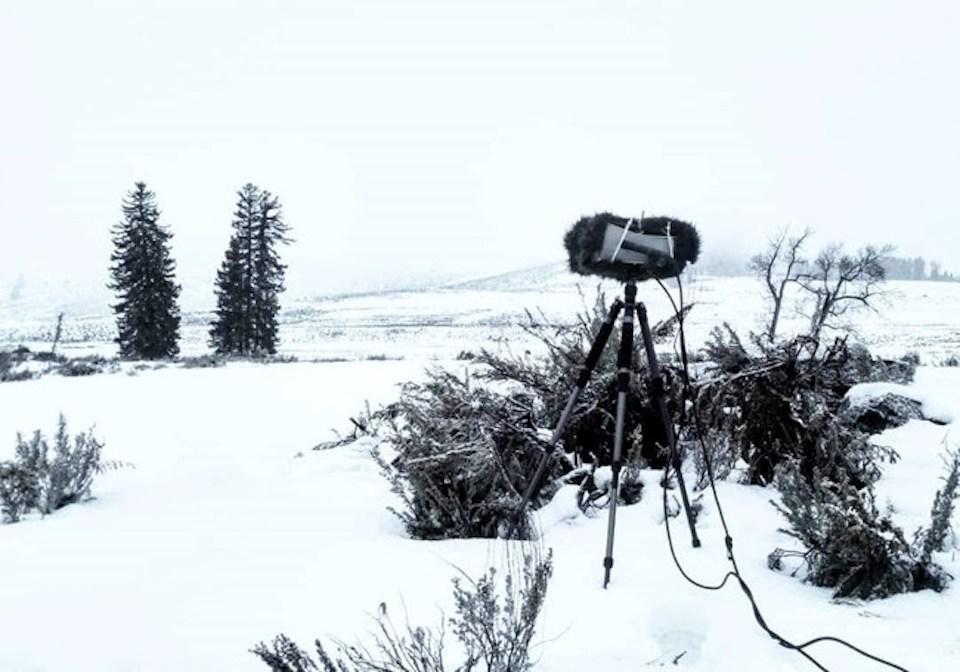
Snowy, wintry view of microphones installed in a binaural configuration to record natural sounds in Yellowstone National Park/ Photo courtesy Jacob Job
Job said he struggles with his editorial decisions. “There is a debate among natural sound recordists as to what sort of editing is ethical or should be allowed. If I remove all anthropogenic noise, then is the final product reality? I worry that I may be setting up a false expectation. Should I leave in the sound of a jet flying overhead to purposefully jar the listener and underscore the impact of noise on the park soundscape?”
No. Instead he chooses to connect people with the incredible range of resources the NPS protects. By providing immersive opportunities for people to hear wildlife as they move through the landscape, he hopes that audiences will be more apt to care about these environments. Protection comes with connection.
To date Job has captured sounds in five national parks: Hawaii Volcanoes, Rocky Mountain National Park, Yellowstone, Sequoia and Kings Canyon, and Lewis and Clark. He discussed these projects, and reflected on some of his listening experiences there.
Hawaii Volcanoes National Park, Hawaii
It all started with a love for birds. With advanced degrees in ecology and biology from Eastern and Western Michigan University, Job’s academic projects focused on birds—how they communicate in an increasingly noisy world, and how humans aid their range expansion. Listening to birds was part of his research. Through his job at the Listening Lab, Job took this passion to Hawaii Volcanoes National Park in May 2015, where he recorded his first dawn chorus at Kīpuka Kī as part of BioBlitz, a National Geographic/National Park Service citizen science event that documents biodiversity. The lush rainforest setting there supports diverse, rare species of plants and animals, including birds.
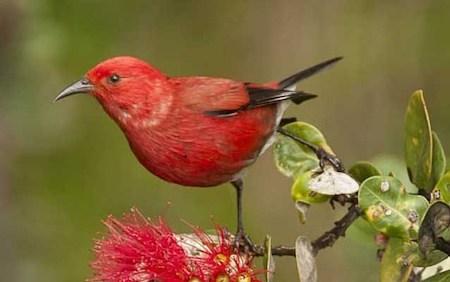
An apapane bird sits in a ōhia tree, Hawaii Volcanoes National Park/NPS, Lynda J. Goff
Job described the scene: “It’s 4 o’clock in the morning, and it’s completely dark. As the sun starts to make the first light, one bird starts singing, and then the rest immediately start in. I’ve never experienced anything like it. In other places birds gradually join in—it’s a slow trickle. Not there. It’s this incredible cacophony that begins out of nowhere.”
Areas like Hawaii that are plentiful in water make for profuse dawn choruses, he said. Where there is water, there is species diversity. One day he wants to record dawn choruses in the eastern USA—another area rich with moisture, species diversity, and, therefore, natural sounds.
Listen to the recording:
https://www.nps.gov/havo/learn/nature/dawn-chorus.htm.
Sequoia and Kings Canyon National Parks, California
For an entirely different chorus, in June 2018 Job will record Pacific chorus frogs—also known as Pacific tree frogs—in Sequoia and Kings Canyon National Park. Chorus frogs are abundant throughout the Northwest, with a range that extends from Baja, California to British Columbia. The loud croaks and trills of male frogs during spring breeding pulse through the air from under the canopy of ancient Sequoia trees and across wetland meadows. They start singing in the early evening and continue through dawn, at which time bird songs gradually replace them.
Job’s work in the park is part of a year-long assignment. The recordings of frogs and other creatures will be used in an educational film about the importance of natural sounds, and also a story map for the Visitor Center. He’s already gathered some rarely heard sounds, including Western Screech owls mating late at night in the Blue Oak Woodlands of Sequoia. Job likened the sounds of their beating wings and clicking beaks to an alien air raid.
Listen to the recording:
https://soundcloud.com/gaviaimmer/western-screech-owls-bill-clacking-sequoia-national-park
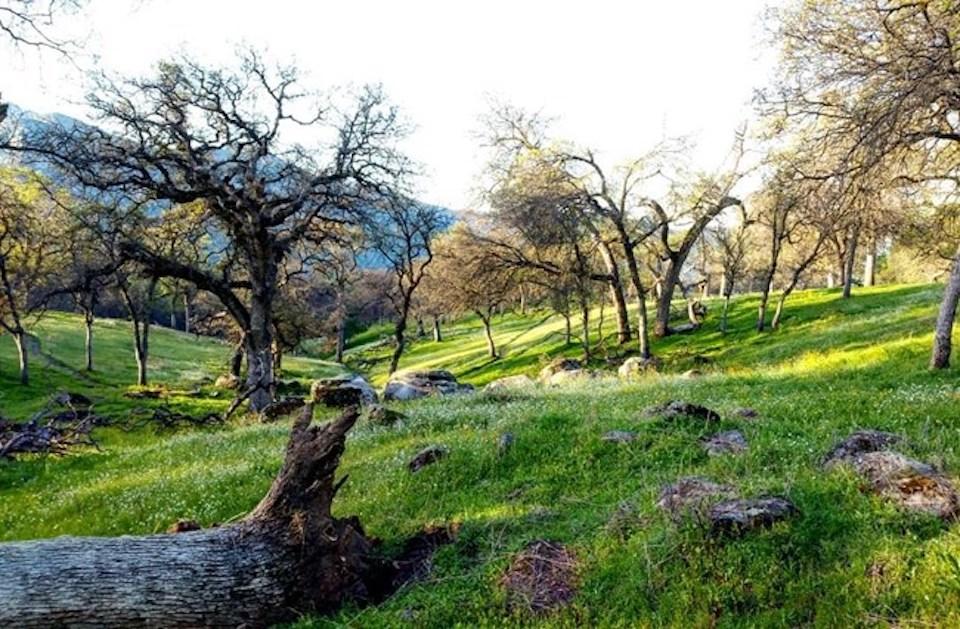
Wildflower grass carpets canyon ground with outcroppings of rock and trees in Sequoia and Kings Canyon National Park, California/Photo courtesy of Jacob Job
Lewis and Clark National Historical Park, Oregon
Cultural sounds are another important aspect of park soundscapes. They tell a story about the history of place. At Lewis and Clark National Park, Job recorded sounds to paint a picture of the past and bring that story to life for us today. The idea was to capture sounds that pioneers with the Lewis and Clark Corps of Discovery might have heard as they made their way to the Pacific coast, ending their journey near Astoria. What sounds would these have been?
“As they explored the area they would likely have heard the sounds of rushing rivers, the distant ocean roar, barking sea lions, and the calls of gulls and shore birds,” Job said. “They would also have heard the sounds of people’s activities at Fort Clatsop, their winter encampment, including the firing of muskets, striking of flint for fire making, candle pouring, singing, and playing of instruments such as mouth harps and fiddles.”
Job recorded all of these sounds to recreate a feeling for place similar to what people back then might have experienced. The sounds will be used in an educational, interactive exhibit for park visitors.
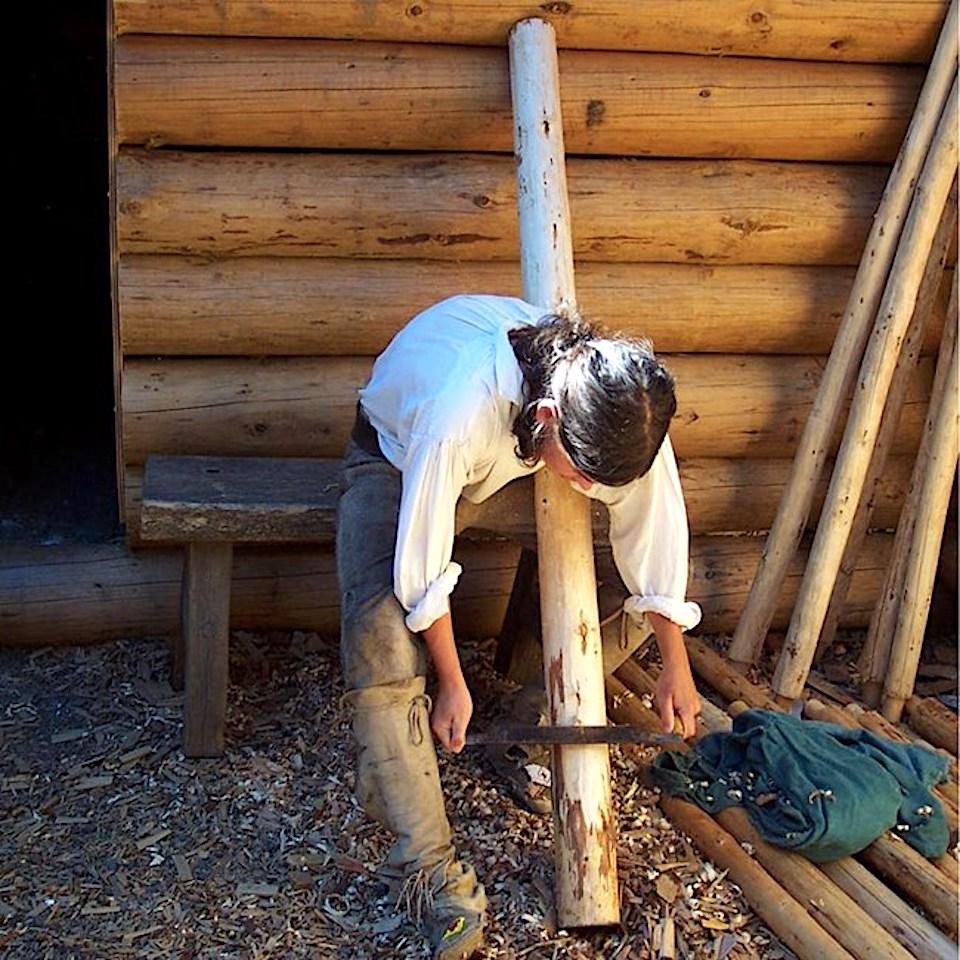
A park ranger, dressed in costume as Corps of Discovery member and carpenter Patrick Gass, scrapes wood off a tree pole. Gass was likely the carpenter in charge of building Camp Dubois, Fort Mandan, and Fort Clatsop/NPS
Listen to the recordings:
Candle pouring: https://soundcloud.com/gaviaimmer/candle-pouring-demonstration-lewis-and-clark-national-historical-park
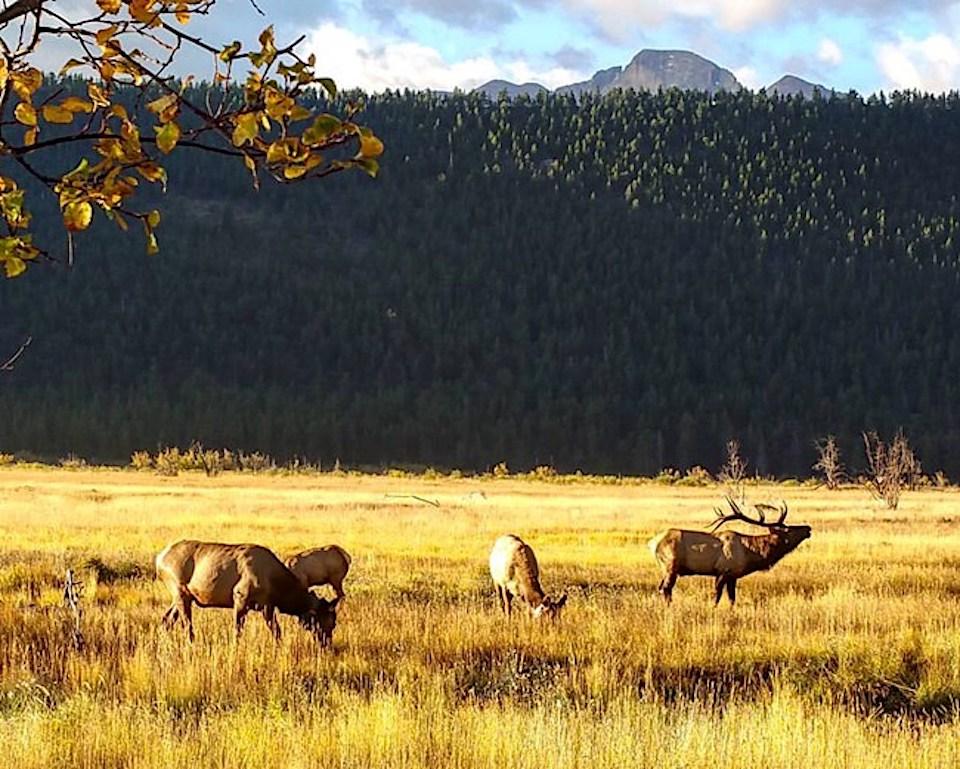
A bugling elk grazes in a golden meadow with female elk in autumn at Rocky Mountain National Park, Colorado/Photo courtesy of Jacob Job
Rocky Mountain National Park, Colorado
On any given night in autumn, the haunting sounds of bugling elk can be heard in the Rocky Mountains. Elk travel in herds throughout the park and Front Range, and are among the animals most easily sighted by park visitors. With their rack of antlers and feisty behavior, they are especially interesting to observe during rutting season when bulls seek mates. Their sounds can be heard for miles. Job described one field recording that perfectly captured the season’s drama:
“The bulls were bugling and chasing the females, and they were fighting with each other, and their antlers were banging. You can hear them stomping through the water and grass, and making this glug sound, which you don’t normally hear. Then, if that’s not enough, a coyote 30 yards behind us starts howling for 10 minutes! And the best part? There were no people talking. It was the luckiest thing.”
Listen to the recording:
https://soundcloud.com/gaviaimmer/elk-rut-and-coyote-rocky-mountain-national-park
Jacob has added these and other sounds to the park’s sound library: https://www.nps.gov/romo/learn/photosmultimedia/soundlibrary.htm
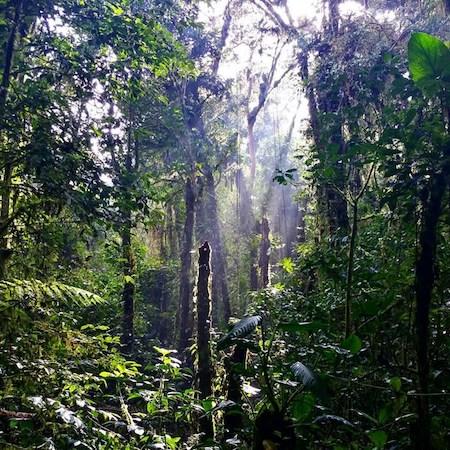
Lush view inside dense, tropical rainforest, La Selva Biological Research Station, Costa Rica/Photo courtesy of Jacob Job
Parting Thoughts
Circling back to Yellowstone, Job discussed ongoing, educational outreach projects for the park including Yellowstone’s Sound Library, and also Audio Postcards, short video vignettes that express a rich variety of life in the park through sounds. CSU students help with this effort.
What does Job do when he’s not recording or analyzing natural sounds for the NPS? Recording and analyzing natural sounds for himself, of course!
Job waxed enthusiastically about other field trips he’s taken, such as to Costa Rica, where he stayed at the distinguished La Selva Biological Station, a tropical rainforest research center located within the protected Cordillera Volcánica Central Biosphere Reserve. As good timing would have it, he was the only one there, and so was able to record a diversity of species without human interference. Among his favorites was the common pauraque, or nightjar, whose piercing, whistling call successively rises and falls in cadence as if stuck on a loop.
Listen to the recording:
https://soundcloud.com/gaviaimmer/common-paraques-la-selva-biological-reserve-costa-rica
Alone there at the station with his headphones on listening to the rainforest at night, and writing in his journal at an old wooden desk there with all these cubbies, nooks and crannies, Job said, “I felt like one of the early naturalists. These are the things that shape and stay with you forever.” He concluded by saying that he wants people to get outside their comfort zone by staying up later or getting up earlier than they normally would in order to observe the power of nature.
“And when you do, be mindful of your own noise, and good things will come to you,” he said. “You’ll experience a different nature than you currently know or thought was possible.”
To browse more of Job’s recordings from around the world, visit his website on Soundcloud: https://soundcloud.com/gaviaimmer. Close your eyes and connect!



Comments
This is a totally cool article. I loved listening to these recordings and it just goes to prove that national parks are so much more than what we see with our eyes. It's about listening, as well. Thank you, Dr. Job.
What a great job to have!